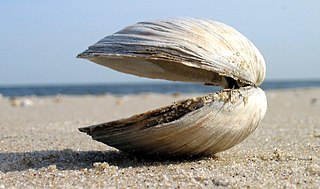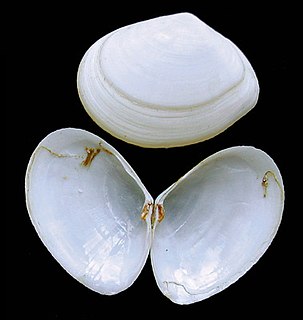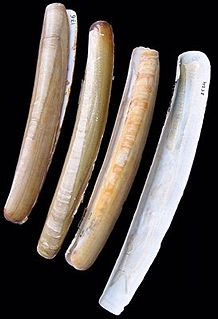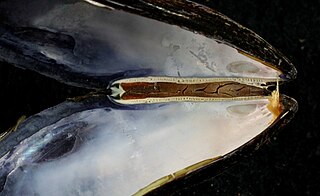
Clam is a common name for several kinds of bivalve molluscs. The word is often applied only to those that are edible and live as infauna, spending most of their lives halfway buried in the sand of the seafloor or riverbeds. Clams have two shells of equal size connected by two adductor muscles and have a powerful burrowing foot. They live in both freshwater and marine environments; in salt water they prefer to burrow down into the mud and the turbidity of the water required varies with species and location; the greatest diversity of these is in North America.

Bivalvia, in previous centuries referred to as the Lamellibranchiata and Pelecypoda, is a class of marine and freshwater molluscs that have laterally compressed bodies enclosed by a shell consisting of two hinged parts. Bivalves as a group have no head and they lack some usual molluscan organs like the radula and the odontophore. They include the clams, oysters, cockles, mussels, scallops, and numerous other families that live in saltwater, as well as a number of families that live in freshwater. The majority are filter feeders. The gills have evolved into ctenidia, specialised organs for feeding and breathing. Most bivalves bury themselves in sediment where they are relatively safe from predation. Others lie on the sea floor or attach themselves to rocks or other hard surfaces. Some bivalves, such as the scallops and file shells, can swim. The shipworms bore into wood, clay, or stone and live inside these substances.

Clam shrimp are a taxon of bivalved branchiopod crustaceans that resemble the unrelated bivalved molluscs. They are extant, and known from the fossil record, from at least the Devonian period and perhaps before. They were originally classified in a single order Conchostraca, which later proved to be paraphyletic, being separated into three different orders: Cyclestherida, Laevicaudata, and Spinicaudata.

A siphon is an anatomical structure which is part of the body of aquatic molluscs in three classes: Gastropoda, Bivalvia and Cephalopoda.
A molluscivore is a carnivorous animal that specialises in feeding on molluscs such as gastropods, bivalves, brachiopods and cephalopods. Known molluscivores include numerous predatory molluscs,, arthropods such as crabs and firefly larvae, and, vertebrates such as fish, birds and mammals. Molluscivory is performed in a variety ways with some animals highly adapted to this method of feeding behaviour. A similar behaviour, durophagy, describes the feeding of animals that consume hard-shelled or exoskeleton bearing organisms, such as corals, shelled molluscs, or crabs.

Tridacna crocea, the boring clam, crocus clam, crocea clam or saffron-coloured clam, is a species of bivalve in the family Cardiidae. It is native to the Indo-Pacific region. It is occasionally found in the aquarium trade where it is often simply referred to as crocea.
A mollusc valve is each articulating part of the shell of a mollusc. Each part is known as a valve or in the case of chitons, a "plate". Members of two classes of molluscs: the Bivalvia (clams) and the Polyplacophora (chitons) have valves.

A bivalve shell is part of the body, the exoskeleton or shell, of a bivalve mollusk. In life, the shell of this class of mollusks is composed of two hinged parts or valves. Bivalves are very common in essentially all aquatic locales, including saltwater, brackish water, and freshwater. The shells of bivalves commonly wash up on beaches and along the edges of lakes, rivers, and streams. Bivalves by definition possess two shells or valves, a "right valve" and a "left valve", that are joined by a ligament. The two valves usually articulate with one another using structures known as "teeth" which are situated along the hinge line. In many bivalve shells, the two valves are symmetrical along the hinge line—when truly symmetrical, such an animal is said to be equivalved; if the valves vary from each other in size or shape, inequivalved. If symmetrical front-to-back, the valves are said to be equilateral, and are otherwise considered inequilateral.

Mya truncata, common name the blunt gaper or truncate softshell, is a species of edible saltwater clam, a marine bivalve mollusk in the family Myidae.

Juliidae, common name the bivalved gastropods, is a family of minute sea snails, marine gastropod mollusks or micromollusks in the superfamily Oxynooidea, an opisthobranch group. These are sacoglossan (sap-sucking) sea snails, and many of them are green in color.

Ensis ensis, or the sword razor, is a razor clam, a marine bivalve mollusc in the family Pharidae. It lives buried in the sand and is found off the coasts of northwest Europe.

Cyrtopleura costata, or the angel wing clam, is a bivalve mollusc in the family Pholadidae. It is found in shallow parts of the northwest Atlantic and also in the North Sea of Scotland coastline and west coast of the Adriatic Sea by a remote area in the Marche region in central Italy, living in the seabed, where it digs its burrows on a very slow revolving movement for years through soft sand and mud always to a max depth of 8ft but always below 3 feet (0.91 m) at the lowest tide.

Mulinia lateralis, the dwarf surf clam or coot clam, is a species of small saltwater clam, a bivalve mollusc in the family Mactridae. It occurs in the western Atlantic Ocean and the Caribbean Sea.
Enigmonia is a genus of saltwater clams, a marine bivalve mollusc in the family Anomiidae, the jingle shells. Enigmonia aenigmatica, the mangrove jingle shell clam, is the only species in this monotypic genus. It is found living on mangroves in the Indo-Pacific Ocean.

Venerupis corrugata, the pullet carpet shell, is a species of bivalve mollusc in the family Veneridae. It is found buried in the sediment on the sea bed in shallow parts of the eastern Atlantic Ocean. It is harvested for human consumption in Spain and other parts of Western Europe.

The umbo is the vaguely defined, often most prominent, highest part of each valve of the shell of a bivalve or univalve mollusk. It usually contains the valve's beak, the oldest point of the valve, and its degree of prominence and its position relative to the hinge line are sometimes helpful in distinguishing bivalve taxa. The umbo forms while the animal is a juvenile, and radial growth subsequently proceeds around that area. The umbo is situated above the hinge line. In those bivalves where the umbones do not protrude, as is the case for example in some mussels, the umbones can nonetheless usually be readily identified by examining the concentric growth lines of the shell.

A prodissoconch is an embryonic or larval shell which is present in the larva of a bivalve mollusk. The prodissoconch is often but not always smooth, and has no growth lines. It is sometimes still present and visible in the adult shell, if there has been no erosion of the shell in that area.

A hinge ligament is a crucial part of the anatomical structure of a bivalve shell, i.e. the shell of a bivalve mollusk. The shell of a bivalve has two valves and these are joined together by the ligament at the dorsal edge of the shell. The ligament is made of a strong, flexible and elastic, fibrous, proteinaceous material which is usually pale brown, dark brown or black in color.

The adductor muscles are the main muscular system in bivalve mollusks, i.e. in clams, scallops, mussels, oysters, etc. In many parts of the world, when people eat scallops, the adductor muscles are the only part of the soft parts of the animal which are eaten. Adductor muscles leave noticeable scars or marks on the interior of the shell's valves. Those marks are often used by scientists who are in the process of identifying empty shells to determine their correct taxonomic placement.

Solecurtus strigilatus, also known as the rosy razor clam, is a species of saltwater clam, a marine bivalve mollusc in the family Solecurtidae. This mollusc is a suspension feeder and can burrow with great rapidity to escape predators. It is an unusual bivalve in that its shell valves are too small to contain all the soft tissue, and the animal is unable to retreat into its shell.
















